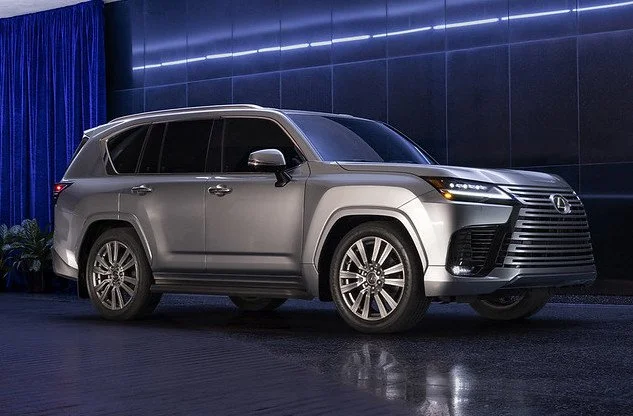Lexus juggernaut almost here … and already gone
/Either Kiwis have a big thing for full-sized luxury off-roaders – or very few have arrived.
TWO same-priced versions – one with ‘F’ performance-theming and five seats, the other with a more traditional fit-out and seven chairs – but don’t be in a hurry to secure one.
Though the LX, the Lexus version of the Land Cruiser 300 Series, has just released in New Zealand in Limited and F-Sport turbodiesel formats, both for $175,900, you’re out of luck if still thinking about buying in.
All of this year’s allocation of 100 units has been secured, so any order placed from now on won’t be met until 2023, the local arm has related. Exactly when next year appears open-ended as well.
“If a customer orders one today it will go into either 2023 allocation, or if possible and if any more come available to our market we will try to meet that order sooner - so it is difficult to give an exact month for delivery in 2023,” says Lexus NZ general manager Andrew Davis.
Lexus NZ’s boss cites the reason for this as being “unprecedented demand.” He adds: “(The) reason is purely that global demand for the new model has well exceeded our current production capacity.”
A recent overseas’ report paints a different picture. In mid-February the Motor1.com website suggested production of this model has been hindered by significant issues sourcing components from suppliers in South East Asia. This has impacted particularly harshly in Japan; Motor1 says it has an advisory saying there’s a four year wait for one version of the Lexus there.
In reporting this as a product release might be premature, too. Really, it’s an announcement as Lexus NZ says only that the model avails ‘in March’.
Does that mean any examples are even here yet? That it can only provision international exterior images of left-hand drive product, rather than follow the usual practice of facilitating a portfolio of shots of NZ-plated products, raises a red flag.
As previously reported, the LX follows time-honoured theme; it’s really a super-luxed Land Cruiser, hence why it sits comfortably above the LC 300, which spans from $124,900 (VRX) through to $144,990 (GR Sport).
The pricing shows improvement, in that the previous LX was a big sticker item in selling for $160,400 with a less grunty diesel than it has now and $181,700 with a V8 petrol that would have been impossible to release in a Clean Car environment.
In saying that, the 227kW/700Nm 3.3-litre twin turbo V6 now being used is likely to attract a tax of several thousand dollars in its Toyota and Lexus applications, given its CO2 count of 268 grams per kilometre is well above the 192g/km point where penalties apply. The brand nonetheless contends it is a cleaner engine than the previous choices.
Lexus NZ has not indicated which of the two variants – out of a possible seven it could have conceivably taken – will be more popular, or if it might taken other options.
It says “the question of which model to purchase comes down to the customer’s needs. The seven seat Limited model offers ultimate luxury, while the five seat F Sport places more emphasis on performance and maintains a luxury cabin experience.”
Davis says the LX is about being able to move around comfortably, in any situation, in luxury.
“Being able to go anywhere is a key feature of the LX 500d. But this is far more than a typical four-wheel drive SUV.
“It has a level of refinement that is unsurpassed – it is the ultimate luxury vehicle for more extreme kiwi lifestyles and even through rocky and rough terrain the landings are soft,” he says.
“The Lexus engineers have achieved a lower weight but have made the LX very sturdy with a lower centre of gravity.”
Reiterating comment made last year when the model made its international debut, Davis says he would have liked to have had it in hybrid or even full electric format.
“ … but we are not quite there yet. The key factor is what our customers require from an LX and the availability of reliable and durable off-roading technology.
“Many LX 500ds will be sold to customers around the world who may drive long distances to isolated locations that don’t have access to charging stations.
“Globally the LX is in high demand, and it’s no different here in New Zealand, this unfortunately means that customers can expect a wait time of over 12 months for new orders.”
The new engine generates an additional 27kW and 50Nm over the previous V8 diesel. Combined fuel consumption is lower at 8.9L/100km.
As per the donor, many measures have been taken to save weight as a means of improving responsiveness and fuel consumption. Aluminium has been adopted for the bonnet, roof, and door panels. The use of new high-tensile strength steel in the frame, lighter seat construction, and revised suspension also contribute to the savings. But it’s still a chunky thing at 2660kg.
The LX’s interior design is based on the ‘Tazuna’ cockpit adopted for the new Lexus NX, launched in 2021. The brand cites a whole new generation of connectivity, safety, and driver aids all at the drivers’ fingertips.
Lexus takes pride in the level of luxury and attention to detail across the interior of both models. It offers that the Limited features a hand-crafted wooden mosaic with patterns influenced by hawk feathers. The F Sport has a more performance orientated interior with aluminium features inspired by patterns found on a traditional Japanese sword.
The models run on 22-inch rims – so, four inches larger than those on the GR Sport, for instance – and each has its own alloy wheel design. The F Sport exterior design is also different from the Limited with a unique front bumper, grille, and rear bumper.



















